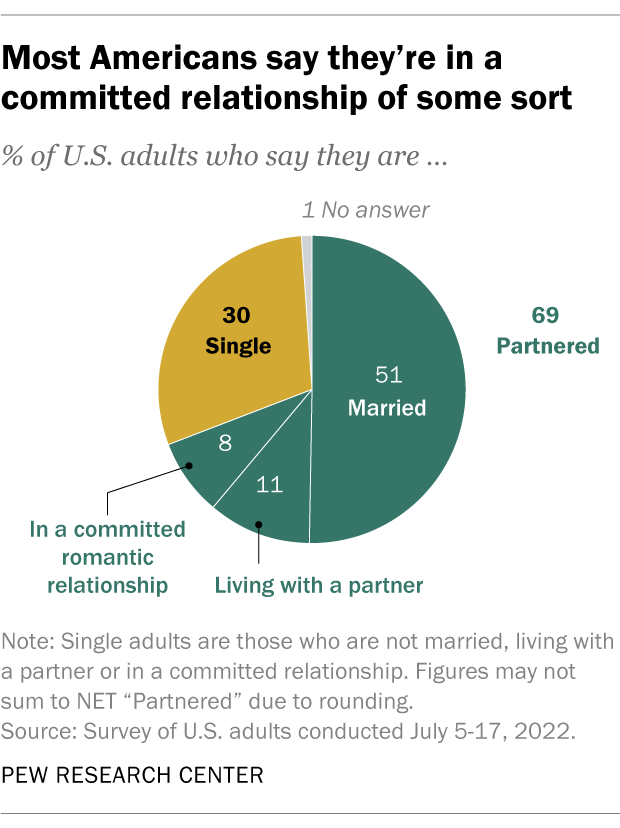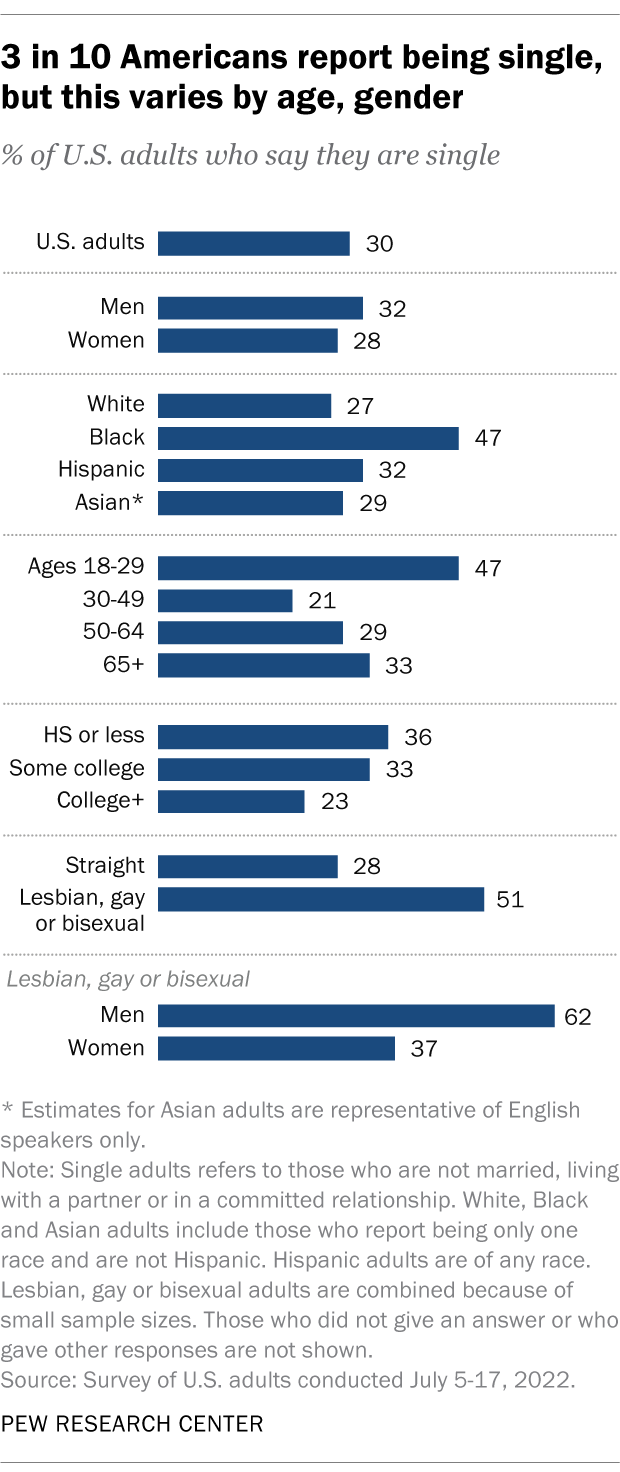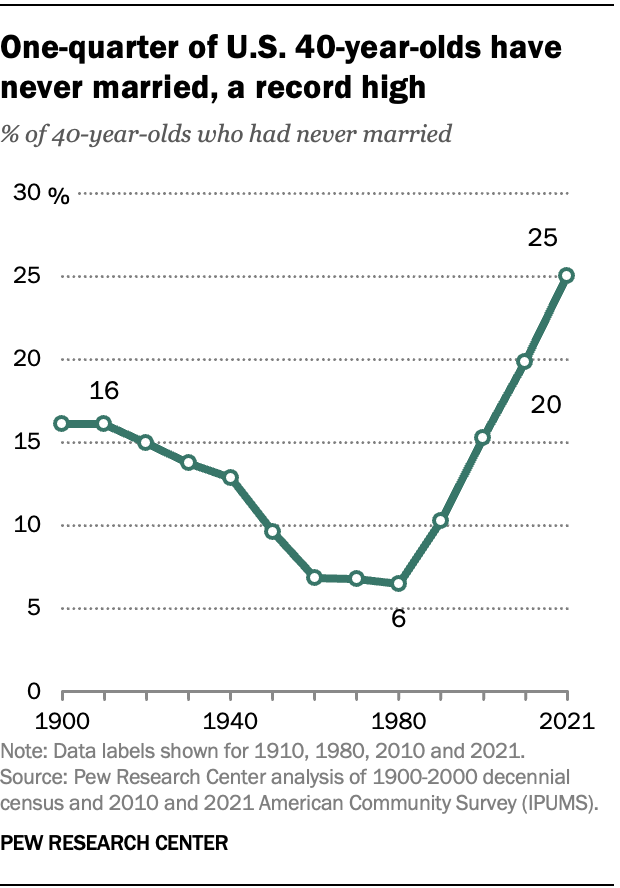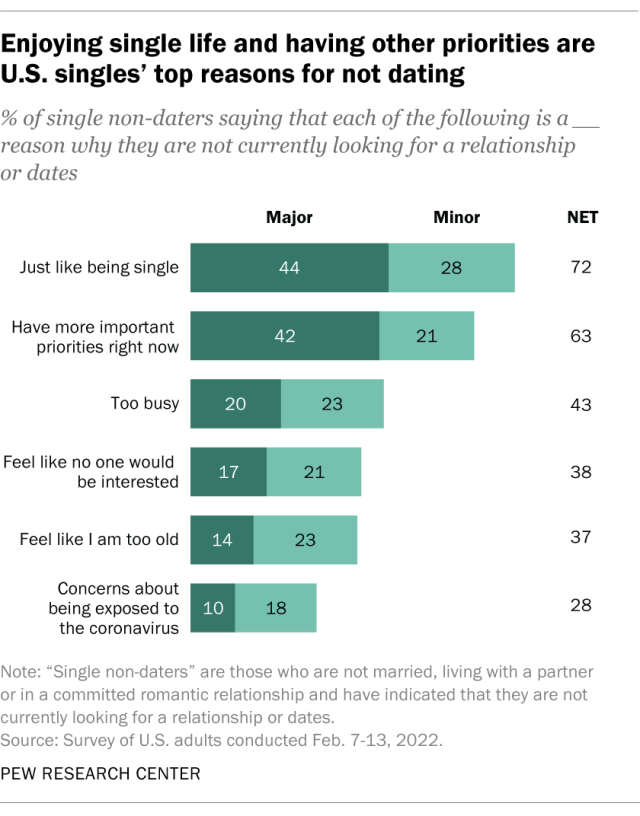
This month, many Americans will celebrate Valentine’s Day with important people in their lives, whether it’s their romantic partner or their closest friends. Ahead of the holiday, here are some key facts about marriage and dating in the United States, taken from Pew Research Center surveys and other analyses.
Pew Research Center conducted this analysis to create a snapshot of Americans’ views of and experiences with marriage, dating and being single. It is based on recent surveys conducted by the Center. Links to these surveys, including information about the field dates, sample sizes and other methodological details, are available in the text.
Most Americans say they’re in a committed relationship of some sort, according to a July 2022 Center survey. Overall, 69% of Americans say they are married (51%), living with a partner (11%), or otherwise in a committed romantic relationship (8%).
Around four-in-ten adults are not married or cohabiting: 22% have never been married, and smaller shares are divorced (10%), separated (2%) or widowed (5%).

Three-in-ten Americans say they are single, according to the same survey. In this analysis, singles include those who are not married, living with a partner or in a committed romantic relationship.
Some demographic groups have higher shares of single people:
- Younger adults, especially young men: 47% of adults under 30 are single, compared with smaller shares of those ages 30 to 49 (21%), ages 50 to 64 (30%), and 65 and older (39%). Men under 30 are far more likely to be single than women in the same age group. Young men are also more likely than older men to say this is their relationship status.
- Black adults: 47% report being single, compared with about three-in-ten in other racial and ethnic groups.
- Those without a college degree: 36% of those with a high school diploma or less education report being single, while 23% of those with at least a four-year college degree say the same.
- Lesbian, gay or bisexual adults: 51% are single, compared with 28% of straight adults.

A record share of 40-year-olds have never been married, according to a Center analysis of the most recent U.S. Census Bureau data. As of 2021, a quarter of 40-year-olds in the U.S. had never been married – up from 6% in 1980. While many unmarried 40-year-olds live with a romantic partner, most do not. In 2022, for instance, 22% of never-married adults ages 40 to 44 were cohabiting.
Among 40-year-olds, Black Americans, men and those without a four-year college degree are the most likely to have never married.
A Center survey conducted in April 2023 found that relatively few Americans (23%) see marriage as essential for people to live a fulfilling life. Far more say this about factors like job satisfaction (71%) and having close friends (61%).

Three-in-ten U.S. adults say they have ever used a dating site or app, according to the July 2022 survey. That includes 9% who did so in the year before the survey. Adults under 30 (53%) and lesbian, gay or bisexual adults (51%) are more likely than those in other groups to say they have dated online at any point.
Among current and recent dating platform users, 44% say meeting a long-term partner is a major reason they have used these sites or apps, and 40% say the same for dating casually. About a quarter say that having casual sex or making new friends are each major reasons they use these sites or apps.

One-in-ten partnered adults met their current significant other through a dating site or app, the same survey found. Partnered adults are those who are married, living with a partner or in a committed romantic relationship. Those who are under 30 or who are lesbian, gay or bisexual stand out on this measure: 20% of partnered adults under 30 say they met their current spouse or partner on a dating site or app, as do 24% of partnered lesbian, gay or bisexual adults.
Nearly half of Americans who were single and looking to date in the year before the July 2022 survey turned to online dating. That year, 45% of single Americans who were searching for a relationship and/or casual dates used an online dating platform, including those who were using one at the time of the survey.
Daters were already unhappy with their romantic lives, but the coronavirus outbreak made things more difficult, according to surveys fielded before and during the pandemic. In 2019, two-thirds of single-and-looking adults said their dating lives were not going well, and three-quarters said it was difficult for them to find people to date.
In February 2022, 63% – including similar shares of men and women – said dating got even harder during the pandemic. Another 32% said it stayed about the same, and just 3% said it got easier.
A majority of single Americans aren’t looking for romance on Valentine’s Day – or any other time, according to the February 2022 survey. Overall, 56% of single adults said they were not looking for a relationship or casual dates at that time. Majorities of single adults who weren’t looking for a relationship or dates cited enjoying being single (72%) and having more important priorities (63%) as at least minor reasons why.

Note: This is an update of a post originally published on Feb. 11, 2021.



